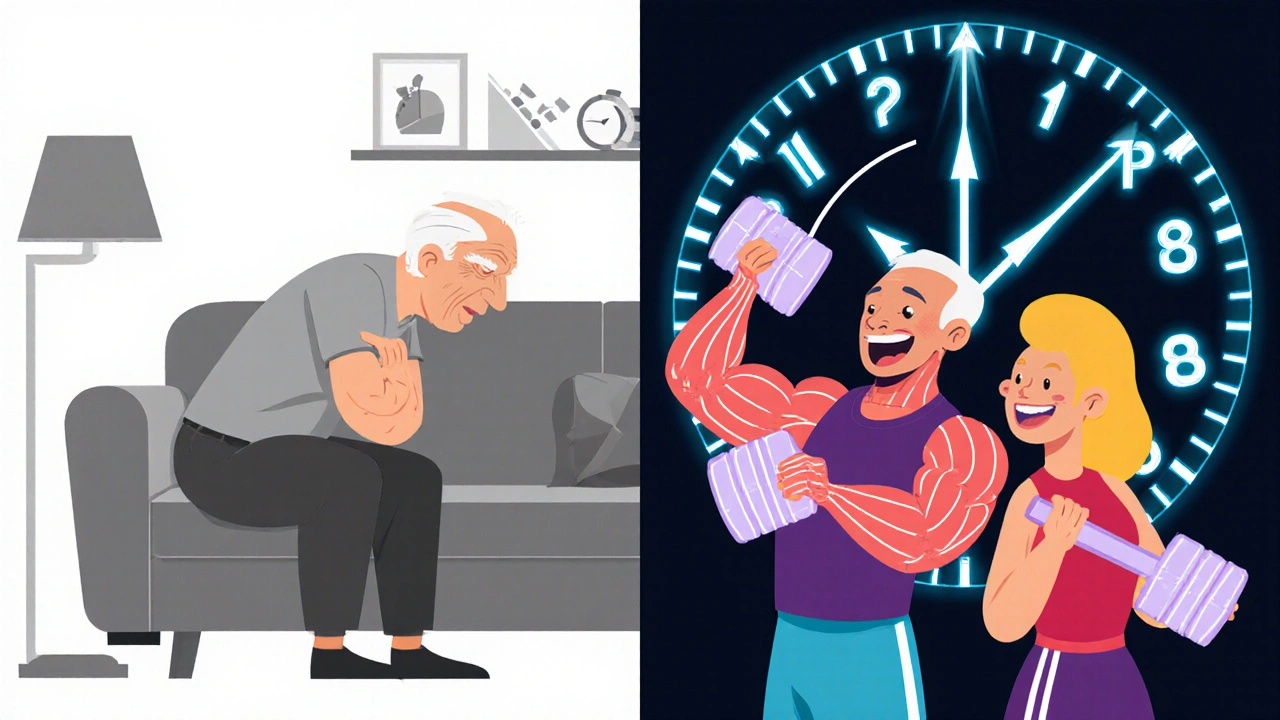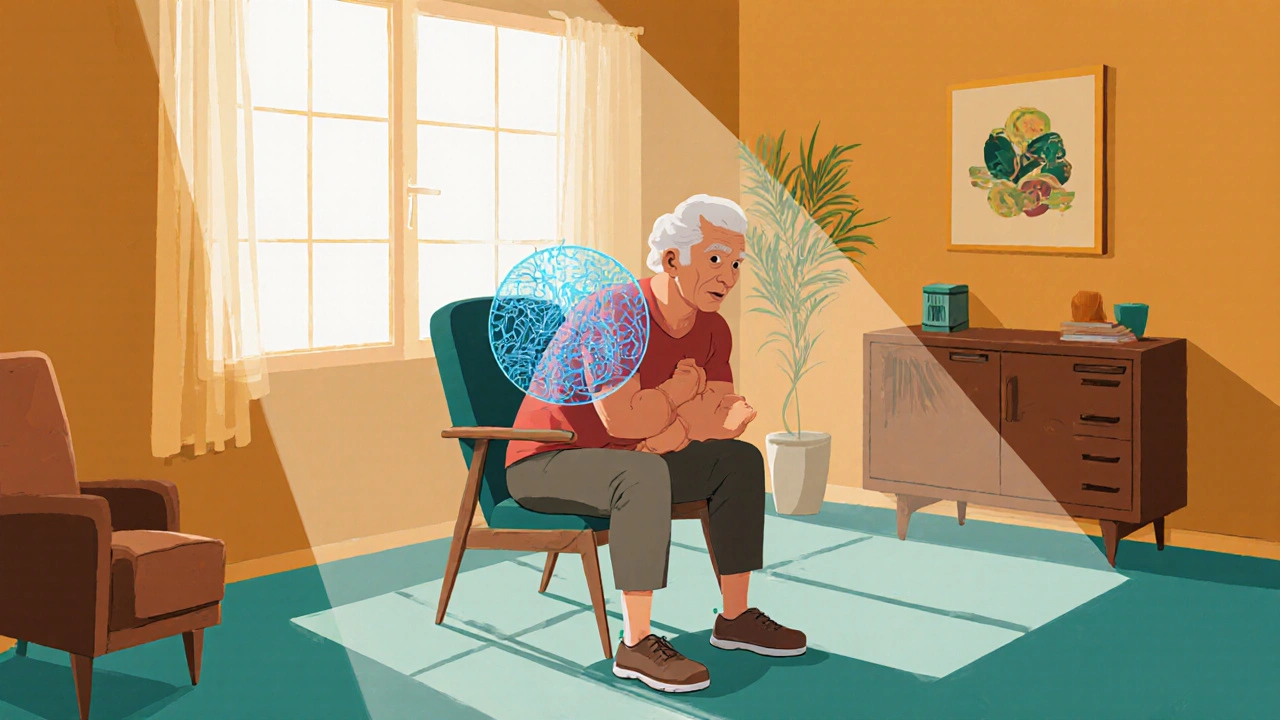By your 40s, you might notice it: carrying groceries feels harder, getting up from a chair takes more effort, or you’re less steady on your feet. It’s not just getting older-it’s sarcopenia. This isn’t normal aging. It’s a real, measurable loss of muscle mass and strength that starts quietly in your 30s and accelerates after 65. Left unchecked, it increases your risk of falls, fractures, hospital stays, and losing independence. The good news? Strength training isn’t just helpful-it’s the most powerful tool we have to stop it in its tracks.
What Exactly Is Sarcopenia?
Sarcopenia isn’t just feeling weaker. It’s a medical condition defined by the loss of skeletal muscle mass, strength, and physical function due to aging. First recognized as a distinct condition in 1989, it’s now diagnosed using clear standards: handgrip strength below 27kg for men or 16kg for women, walking speed slower than 0.8 meters per second, and low lean muscle mass measured by a DXA scan (below 7.0kg/m² for men, 5.5kg/m² for women). These aren’t arbitrary numbers-they’re based on decades of research from the European Working Group on Sarcopenia in Older People (EWGSOP3, 2023).
By age 60, about 1 in 10 adults have sarcopenia. By 80, that jumps to nearly half. In the U.S. alone, it costs $18.5 billion a year in healthcare expenses. And it’s not just about looking less toned. The real danger is functional decline-struggling to climb stairs, rising from a toilet, or even standing up from a couch. These aren’t minor inconveniences. They’re early warnings that your body is losing the ability to protect itself.
Why Does Muscle Disappear as We Age?
Your muscles don’t just fade-they’re actively broken down and poorly rebuilt. Several biological changes drive this:
- Motor neurons die off at 3-5% per year after 60, disconnecting nerves from muscle fibers.
- Type II (fast-twitch) muscle fibers, responsible for power and quick movements, shrink by 30-40% by age 80.
- Satellite cells-your body’s muscle repair crew-drop by 50-60% in activity by age 70.
- Your muscles become less responsive to protein, with protein synthesis rates falling 20-25%.
- Chronic low-grade inflammation rises, with IL-6 and TNF-alpha levels up by 30-50%.
This isn’t just about being inactive. Even people who stay active lose muscle over time. The body’s natural repair systems slow down. It’s like your muscle-building factory is running on half-power, while the breakdown side keeps humming along.
Sarcopenia vs. Other Muscle Problems
Not all muscle loss is the same. It’s easy to confuse sarcopenia with other conditions:
- General atrophy happens when you’re bedridden or injured-muscle drops fast, but it’s reversible with movement.
- Cachexia is tied to serious illness like cancer or heart failure, involving weight loss, fatigue, and metabolic chaos.
- Dynapenia is strength loss without significant muscle mass loss-still dangerous, but different.
- Sarcopenic obesity affects 15-20% of older adults: low muscle, high fat. It’s especially risky because fat tissue worsens inflammation.
Sarcopenia is unique because it’s age-related, gradual, and requires both muscle loss and functional decline to be diagnosed. You can have low muscle without sarcopenia-but if you’re also struggling to move, you’re in the danger zone.
Strength Training: The Proven Fix
Here’s the hard truth: no pill, supplement, or therapy has come close to matching the results of strength training. Multiple studies confirm it.
Dr. Jeremy Walston from Johns Hopkins found that older adults gain 1-2kg of muscle and boost strength by 25-30% in just 12-16 weeks of resistance training. Dr. Anne Newman at the University of Pittsburgh showed that twice-weekly training improves walking speed by 0.1-0.2m/s and cuts fall risk by 30-40%. That’s not a small gain-it’s the difference between needing help to get up and doing it on your own.
A 2022 survey of over 3,200 older adults found that 75% of those who trained twice a week kept their independence in daily tasks. Only 58% of non-exercisers did. On Reddit, 68% of users over 65 reported being able to rise from a chair without help after 8-12 weeks of lifting. One 68-year-old man in Vancouver saw his handgrip strength jump from 18kg to 24kg-enough to open jars again. Another 72-year-old woman lowered her fall risk score from 42 to 28 after a 10-week SilverSneakers program.
How to Start (Even If You’re New)
You don’t need a gym membership or heavy weights. Start simple:
- Weeks 1-4: Do bodyweight exercises 2 days a week. Chair squats, wall push-ups, seated leg lifts, and standing calf raises are perfect. Aim for 10-15 reps per set. Rest 60 seconds between sets.
- Weeks 5-8: Add resistance bands (TheraBand light to medium). Use them for seated rows, banded shoulder presses, and leg extensions. Keep reps at 10-15.
- Weeks 9-16: Move to weight machines at the gym or home equipment. Use 60-70% of your one-rep max. Do 2-3 sets of 8-12 reps. Focus on legs, back, chest, and shoulders.
Key rules:
- Exhale when you push or lift. Don’t hold your breath.
- Progress slowly. Increase weight by 2.5-5% every week when reps feel easy.
- Rest 48 hours between sessions. Muscles grow when you rest, not when you train.
- Take 20-30g of protein within 45 minutes after training. Eggs, Greek yogurt, chicken, or a protein shake work.

Common Barriers-and How to Beat Them
Many people quit because they think it’s too hard, too painful, or too expensive. Here’s what actually works:
- Joint pain? Use machines instead of free weights. They guide your movement and reduce stress on knees and shoulders. Reduce range of motion by 20-30% if needed.
- Balance issues? Start seated. Use a sturdy chair for support during standing exercises.
- Too sore? Mild soreness is normal. Sharp pain isn’t. Stop and adjust. Don’t push through pain.
- Can’t afford a trainer? Medicare Advantage plans cover SilverSneakers, which offers free strength classes at gyms and community centers. Over 4.2 million seniors used it in 2022.
- Too lonely? Join a group. Social exercise increases adherence by 35-40%. Find a friend or sign up for a senior fitness class.
Only 28% of U.S. adults over 65 meet the recommended strength training guidelines. That’s not because they don’t want to-it’s because they don’t know how to start safely.
The Bigger Picture
Sarcopenia isn’t just a personal problem-it’s a public health crisis. By 2030, 72 million Americans will be over 65. But there are only 12,500 certified geriatric physical therapists in the country. We need scalable solutions. Telehealth programs, home-based routines, and community classes are filling the gap. A 2022 JAMA study found telehealth strength training is 85% as effective as in-person sessions.
Research is moving fast. The FDA is testing new drugs targeting muscle growth pathways, and AI-powered apps like Exer AI are personalizing workouts to boost adherence by 25%. But none of these replace the simple, proven power of lifting weights-even light ones-regularly.
What you do today matters more than you think. Every time you do a chair squat or lift a resistance band, you’re not just building muscle. You’re building the ability to live independently, to stay safe, to enjoy life without help. That’s not fitness. That’s freedom.
Can sarcopenia be reversed?
Yes, sarcopenia can be significantly reversed-even in your 70s and 80s. Studies show that consistent strength training can add 1-2kg of muscle and improve strength by 25-30% in just 3-4 months. While you may not regain your 20-year-old strength, you can restore enough function to live independently, reduce fall risk, and improve quality of life.
Is walking enough to prevent muscle loss?
Walking is great for heart health and endurance, but it doesn’t build muscle. Sarcopenia is caused by loss of muscle mass and strength, not cardiovascular fitness. To fight it, you need resistance-lifting, pushing, or pulling against weight. Walking alone won’t stop the decline. Combine it with strength training for the best results.
How often should seniors lift weights?
The American College of Sports Medicine recommends 2-3 strength training sessions per week, with at least 48 hours between sessions for recovery. Two days is the minimum for noticeable benefit. Three days is ideal if your body can handle it. Focus on major muscle groups: legs, back, chest, shoulders, and arms. Don’t train the same muscles two days in a row.
Do I need protein supplements?
Not necessarily. Most older adults can get enough protein from food: 20-30g per meal. A 3-ounce chicken breast, a cup of Greek yogurt, or two eggs provide that. Supplements like whey protein can help if you struggle to eat enough, but they’re not required. Focus on whole foods first. Timing matters-get protein within 45 minutes after training to maximize muscle repair.
What if I have arthritis or joint pain?
You can still train safely. Use machines instead of free weights-they control movement and reduce joint stress. Try seated exercises, water-based resistance training, or resistance bands. Reduce range of motion if needed. Always warm up first. Talk to a physical therapist about modifications. Pain during exercise means adjust, not quit. Many people with arthritis see less pain over time as their muscles get stronger and support joints better.
Are there signs I’m progressing?
Yes. Look for these real-life improvements: rising from a chair without using your hands, carrying heavier groceries, climbing stairs without stopping, walking faster, or standing on one foot for 10 seconds. These are better indicators than the scale. Your strength gains show up in daily life-not just in the gym.
Starting strength training later in life isn’t about becoming an athlete. It’s about keeping your body strong enough to do the things you love-playing with grandkids, gardening, traveling, or just walking to the store without help. The science is clear. The tools are available. The only thing missing is the first step.


Write a comment